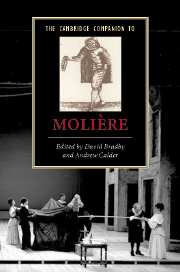Book contents
- Frontmatter
- 1 The career strategy of an actor turned playwright: 'de l’audace, encore de l’audace, toujours de l’audace’
- 2 The material conditions of Molière’s stage
- 3 The master and the mirror: Scaramouche and Molière
- 4 Molière as satirist
- 5 How (and why) not to take Molière too seriously
- 6 L’Avare or Harpagon’s masterclass in comedy
- 7 Laughter and irony in Le Misanthrope
- 8 Comédies-ballets
- 9 Le Bourgeois gentilhomme: Molière and music
- 10 Medicine and entertainment in Le Malade imaginaire
- 11 Molière and the teaching of Frenchness: Les Femmes savantes as a case study
- 12 L'École des femmes: matrimony and the laws of chance
- 13 Molière nationalised: Tartuffe on the British stage from the Restoration to the present day
- 14 Landmark twentieth-century productions of Molière: a transatlantic perspective on Molière: mise en scène and its historiography
- 15 Dom Juan the Directors’ Play
- 16 ‘Reculer pour mieux sauter’: modern experimental theatre’s debt to Molière
- Select bibliography
- Index
- Series List
8 - Comédies-ballets
Published online by Cambridge University Press: 28 March 2007
- Frontmatter
- 1 The career strategy of an actor turned playwright: 'de l’audace, encore de l’audace, toujours de l’audace’
- 2 The material conditions of Molière’s stage
- 3 The master and the mirror: Scaramouche and Molière
- 4 Molière as satirist
- 5 How (and why) not to take Molière too seriously
- 6 L’Avare or Harpagon’s masterclass in comedy
- 7 Laughter and irony in Le Misanthrope
- 8 Comédies-ballets
- 9 Le Bourgeois gentilhomme: Molière and music
- 10 Medicine and entertainment in Le Malade imaginaire
- 11 Molière and the teaching of Frenchness: Les Femmes savantes as a case study
- 12 L'École des femmes: matrimony and the laws of chance
- 13 Molière nationalised: Tartuffe on the British stage from the Restoration to the present day
- 14 Landmark twentieth-century productions of Molière: a transatlantic perspective on Molière: mise en scène and its historiography
- 15 Dom Juan the Directors’ Play
- 16 ‘Reculer pour mieux sauter’: modern experimental theatre’s debt to Molière
- Select bibliography
- Index
- Series List
Summary
The resurgence of baroque music in the twentieth century, particularly the music of seventeenth-century France, has boosted interest in a traditionally neglected yet important part of Molière's work: his twelve comédies-ballets. It is high time to remind ourselves that 40 per cent of his output consists of works which combine the spoken word with the arts of music and dance.
In truth this new composite genre created by Molière, a genre which encompasses such a diversity of productions, has an unlikely look about it. Not only is it impossible to classify it or codify its rules with any precision, but even its name is problematic. We call it comédie-ballet, but this term (a poor fit, as it downplays the role of music) was imposed only in the eighteenth century; Molière used the term only once - in his edition of Le Bourgeois gentilhomme (1671) - and then in quite special circumstances: not in order to draw attention to the presence of the three arts throughout the comedy, but precisely because the comedy was followed by a ballet, the Ballet des nations, inserted at the end of the spectacle. In the seventeenth century, gazetteers, chroniclers and publishers were puzzled by this strange genre and uncertain what to call it; they most often used an expression which listed the three arts while giving precedence to comedy; thus Le Malade imaginaire, published after the death of Molière (who, with the exception of Le Bourgeois gentilhomme, always sent his comédies-ballets to the publishers as comédies), was entitled 'comédie melée de musique et de danse' ['comedy mingled with music and dance'].
- Type
- Chapter
- Information
- The Cambridge Companion to Moliere , pp. 107 - 120Publisher: Cambridge University PressPrint publication year: 2006
- 1
- Cited by



